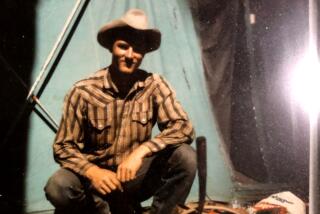Buried in Custer tomes Why Custer’s allure continues
ON June 25, 1876, George Armstrong Custer made a spectacular career move: He lost the Battle of the Little Bighorn and was killed, along with five companies of his men, by warriors of the Sioux, Cheyenne and Arapaho tribes. If he had won, it’s doubtful that we would remember his name today; by losing, and dying, he became, if not the most famous, at least the most written about military officer in U.S. history. (He is certainly the one most depicted on the screen, with dozens of actors, including Errol Flynn, Robert Shaw and even Ronald Reagan donning the buckskin jacket.)
Every aficionado knows the major titles in the Custer literary canon -- Jay Monaghan’s “Custer” (1959), Stephen E. Ambrose’s “Crazy Horse and Custer” (1975) and Evan S. Connell’s “Son of the Morning Star” (1984) to mention just three of the most popular in the last half-century. What’s amazing is that after 132 years there are still so many books being written on Custer and the Little Bighorn, a battle that competes with Gettysburg in terms of literary production. What’s even more amazing is that the definitive books on the Little Bighorn are just now being published. Curiously, though, relatively little has been written on the battle itself -- lots of Indian oral history, lots of speculation, but little researched history. The reason is clear: There were no white survivors to record their memories.
“A Terrible Glory,” by Texas author James Donovan, is probably as close as we’re going to get to knowing what really happened. Donovan’s account is gloriously free of the sociopolitical agendas and rhetorical cant that re-forms around Custer and the battle with each new decade. The frontier cavalrymen Donovan describes are neither heroic bearers of the white man’s burden nor agents of genocide but mostly “undermanned, underpaid, undersupplied, undertrained and underfed” men who often had little experience shooting or even riding. Their opponents were a “warrior culture that trained males from early childhood to fight, ride and survive better than anyone in the world” -- though the various tribes were woefully lacking in organization and cohesion.
One of the best things about “A Terrible Glory” is its lack of agenda: White people thought the way they thought; Indians thought the way they thought; the two ways of thought seldom came together -- and Donovan is content to let it go at that. There’s no attempt to place blame for the disastrous outcome of the battle (which he pieces together using the latest forensic evidence), and none is needed.
Tired and absurdly outnumbered, Custer and all the major officers involved in the campaign grievously underestimated the number of warriors they would be facing and how desperately those warriors would fight. Ultimately Donovan seems to endorse the view of one newspaperman who attributed the “humiliation of defeat . . . to the fact that the several commanders knew nothing of the work to be accomplished or the character to be traversed.” Custer and “virtually every other soldier on the expedition from [Gen. Alfred H.] Terry on down, seemed too obsessed with the hostiles’ scattering to conceive of anything else.” The Seventh Calvary failed at the Little Bighorn because, from the beginning, “there was no mention of any overall plan.” All of which, not to put too fine a point on it, makes the Little Bighorn a splendid metaphor for American military policy in the 21st century.
Probably because Custer was one of the most photographed Americans in the 19th century and a Union Civil War hero, ranking only behind Grant, Sherman and Sheridan in popularity, his death “hit the Centennial -- and the rest of the country -- like a thunderbolt,” Donovan writes.
“As the young nation celebrated its one hundredth birthday and the many technological advances made during its brief existence, the news that its best-known Indian fighter and 262 of his men, troopers of the glorious ‘Fighting Seventh,’ had been annihilated . . . was greeted with grief, outrage, and even disbelief by some. Not since Lincoln’s assassination eleven years earlier had such a shocking story gripped the country.”
Custer, vain as a GQ model and as aware of his own celebrity in his time as a rock star stepping out of a stretch limo in ours, would have been flattered by Michael A. Elliott’s “Custerology,” which attempts to explain why Americans have never lost their fascination with the man and his battle. Elliott, an associate professor of English at Emory University, defines Custerology as “the continuing production of knowledge of Custer in the nineteenth-century Indian Wars in which he fought.”
In pursuit of that knowledge, Elliott traveled from Custer’s childhood home in Monroe, Mich., to the Little Bighorn Battlefield in Crow Agency, Mont. (the Crow fought on the side of the U.S. Army), and visited every related museum and monument in between. Particularly intriguing is a photograph of the mountainside memorial of Custer’s final foe, Crazy Horse, a work in progress, behind a model of the proposed completed sculpture.
The fact that continued fascination with Custer in turn stimulates an increasing interest in Crazy Horse’s people is not ignored by Elliott. He writes that for English-born Custer re-enactor Tony Austin, “portraying Custer’s life means that one can resurrect an attitude toward American Indians that combines respect with combat, admiration with military opposition.”
Custer himself, Elliott claims, “would have never believed that there would be Indians who thought of themselves as Indians in the twenty-first century.” Modernity, Custer and his contemporaries believed, would “crush the indigenous population . . . either physically through extermination or spiritually through assimilation.” That the descendants of the warriors of Little Bighorn might be using Custer’s life and death “to help them understand what it means to be an Indian in the twenty-first century constitutes one of American history’s most elegant, and least appreciated, ironies.”
Custer’s demise, of course, is at the heart of that irony, but if he had known that it would put his name on the covers of books a century later, he no doubt would have judged dying young cheap at the price.
--
Allen Barra is the author of “Inventing Wyatt Earp: His Life and Many Legends” and the forthcoming “Yogi Berra: Eternal Yankee.”
More to Read
Sign up for our Book Club newsletter
Get the latest news, events and more from the Los Angeles Times Book Club, and help us get L.A. reading and talking.
You may occasionally receive promotional content from the Los Angeles Times.








